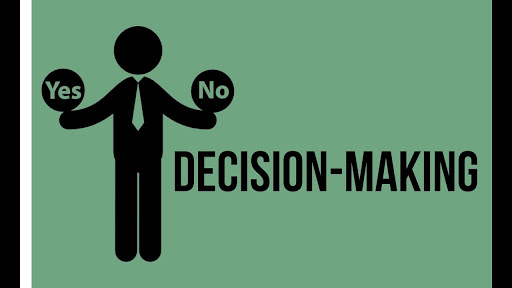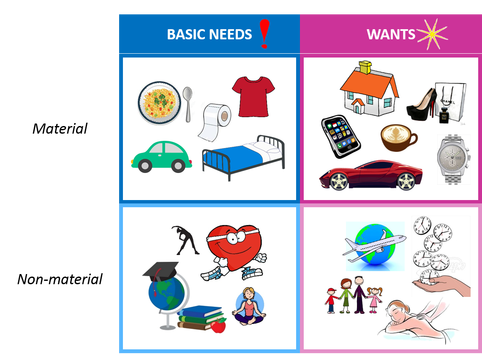Back to: HOME ECONOMICS JSS 2
Welcome to JSS2 Third Term!
We’ve had a remarkable journey from the First term to this moment. We are going to continue our journey into the world of Home Economics.
In today’s class, We will be discussing Resources and Decision Making. Enjoy the class!

RESOURCES AND DECISION MAKING
CONTENT
- Family needs and Resources
- Meaning and Steps in Decision Making
Factors that influence Decision making
Simple Personal Decisions
FAMILY NEEDS
Family needs are things that are essential, that is, very important for a particular family. The family members have physical, emotional, mental and social needs.
Types of needs
- Basic/Primary needs: These are very important things which the family cannot do without. They are those things which every family must have for survival.
The primary needs include:
- a) Food: Provision of good quality food is important for good health and survival.
- b) Shelter/Housing: Every family requires a good shelter for protection.
- c) Clothing: Every family member requires good basic clothing for protection.
- d) Health care: It is important that every member of the family should be healthy. Therefore, every family must provide the health care required.
- Secondary needs/Wants: These are things the family desires but not as important as the primary needs. The family can, therefore, exist without the secondary needs. The secondary needs of a family depend on the socio-economic status of the family.
The secondary needs include car, pocket money, recreation, extra clothing, etc.

SELF EVALUATION
- What are the family needs?
- List the types of needs with examples.
FAMILY RESOURCES
Resources are those things which the family can use to meet their needs and reach their goals. There are different types of resources.
CLASSIFICATION OF RESOURCES
- HUMAN RESOURCES: These are resources which exist within an individual. They are personal qualities of an individual and are different from individual to another. They include:
– Knowledge
– Skills
– Imagination
– Energy
– Time
- MATERIAL/NON-HUMAN RESOURCES: These are resources which exist outside the family but can be controlled, owned or used by the family. They are things which the family use and control to achieve their goals.
The two types of material resources are:
- a) Money: It is used to buy items needed by the family, e.g. house, car, clothing, etc. Money is used to measure the value of family goods. It must be spent wisely.
- b) Possessions: These are the things or items owned by the family, which they can use to attain some goals. Family possessions can be grouped into:
– Those possessions that last a long time and are not used up readily. They are durable, e.g. furniture, cars, houses, etc.
– Those possessions that are used up quickly e.g. clothes, food, etc.
SELF EVALUATION
- What are family resources?
- Mention the two types of resources with examples.
Other resources available to the family are:
- Community resources: Every community has people, facilities, institutions and organizations. These
Help families to improve their skills, solve their problems, enjoy life, etc.
- Natural resources: These are air, water, plants, animals and minerals. They are found in our surroundings and can be used to meet the family’ needs.
CHARACTERISTICS OF RESOURCES
- UTILITY: This means that resources have value or worth. They are useful and can be used to produce goods and services.
- ACCESSIBILITY: The resources must be of easy reach or easy to obtain every time to achieve set goals.
- MANAGEABILITY: This means resources can be controlled for the purpose of achieving goals.
- INTERCHANGEABILITY: A resource is interchangeable when it can be substituted with another resource in order to reach set goals.
SELF EVALUATION
- Mention two other types of resources available to a family.
- List and explain three characteristics of resources.
DECISION MAKING
Decision making is the act of making choices. It is the process of a choice from alternative courses of action or things. It is the ability to make up one’s mind as regards a particular issue or issues. Decision-making comes to action only when there are two or more things to choose from.
IMPORTANCE OF DECISION MAKING
- It helps to minimise mistakes.
- It assists us in taking responsibility for our actions.
- It helps us to identify our values and stand by it.
- It helps us to know more about ourselves and others.
- Decision making also helps us to build self- esteem.
STEPS IN DECISION MAKING
- Identify the decisions to be made: It includes defining the situation or problem that requires a decision. Know what, where and how to solve the problem at hand.
- List the alternatives: Alternatives are different ways of doing a thing. List the alternatives means making a list of possible alternatives and getting information on all the alternatives.
- Choose the best alternative: This involves making the best choice from all the alternatives that will be able to meet your need(s). To do this, you have to think about your values, goals, wants, money available and needs.
- Act on your decision: Carry out your decision to the best of your ability. This means going to buy or do want you have decided.
- Evaluate your decision: This means judging the quality of the decision made or how well it worked for you. Sometimes, if the outcome of a decision is not what you expected, or hope for, you make have to make a new decision.

SELF EVALUATION
- Define the meaning of “Decision Making”.
- List and explain the five steps in decision making.
FACTORS THAT INFLUENCE DECISION MAKING
- Family: Family members are usually willing and eager to help other members, especially teenagers to make good decisions.
- Resources: The human and material resources available will influence ones decision e.g. time, money, knowledge, etc.
- Friends: Friends have a strong influence on each other and can influence each other in decision making.
- Needs and wants: The needs and wants of the family will influence their decision. The needs will be considered before the wants.
- Values: The decisions you make are always based on what you consider important. For example, your value will determine whether you watch a movie or study your books at night.
- Goals: Goals are what you aim to achieve over a period of time. One should be sure that the decision taking fits into one’s plan and is suitable to help in achieving one’s set goals in future.
SIMPLE PERSONAL DECISIONS
Some areas where decisions are made include:
FOOD-RELATED DECISION: This has to do with what to eat, how to eat, when to eat, etc.
CLOTHING-RELATED DECISION: What to wear, how to wear it, with what do I wear it with.
HOUSING-RELATED DECISION: This includes the type of house to build or buy, the types of household articles to buy, etc.
FRIENDS-RELATED DECISION: It has to do with choosing friends to move or associate with.
EDUCATIONAL DECISIONS: It would include which school to attend, books to read, careers to pursue, etc.
As a student, some personal decisions include:
- Buying of textbooks.
- Changing one’s dresses and shoes.
- Choosing the right time to read, play and visit friends.
- Choosing a course of study and a career.
GENERAL SELF EVALUATION QUESTIONS
- Explain the term “decision making”
- List the steps in decision making.
- Differentiate between needs and wants.
- List and explain the types of resources.
- List and explain the types of the family we have.
We have come to the end of this class. We do hope you enjoyed the class?
Should you have any further question, feel free to ask in the comment section below and trust us to respond as soon as possible.
In our next class, we will be talking about Food Nutrients. We are eager to meet you there.

Wow. This site is great, thanks so much
You really saved me a lot of stress. I’ve been looking for a way to beat this topic down for my students. I’m soo grateful. Keep it up
Thanks. Interesting
Please is this the note for family house?
What about the family decision.pls give some examples.
This is amazing…thank you
this really helped me
thanks for this note it’s really helped me
You’re the best…. this served well
List 15 human and non human resources
And classify them in human and non human resources
Glad you found it helpful😊 For even more class notes, engaging videos, and homework assistance, just download our Mobile App at https://play.google.com/store/apps/details?id=com.afrilearn. It’s packed with resources to help you succeed🌟
class notes keep this up… thank you
We’re glad you found it helpful😊 For even more class notes, engaging videos, and homework assistance, just download our Mobile App at https://play.google.com/store/apps/details?id=com.afrilearn. It’s packed with resources to help you succeed🌟
wow ……… this is amazing
Wao! This is a good class. Am going to teach my students and I hope they too will enjoy it as I enjoyed this your own.